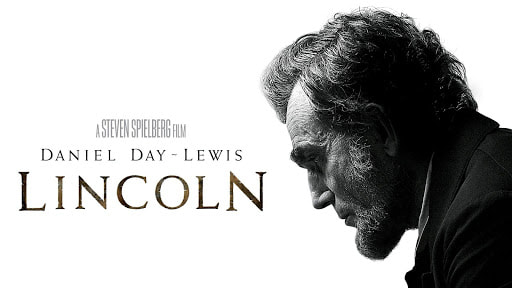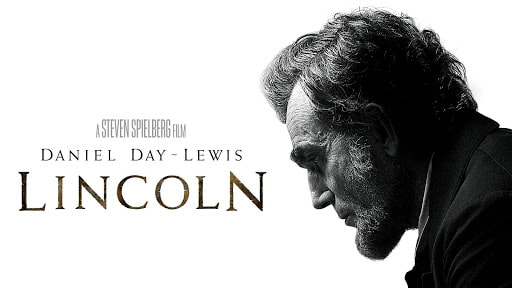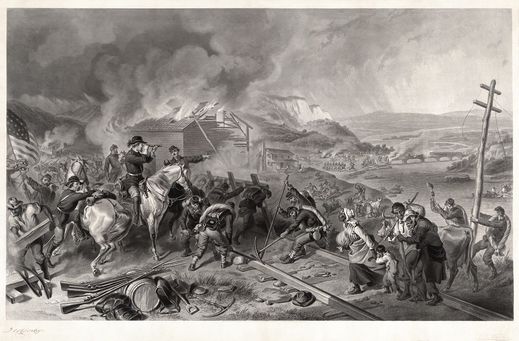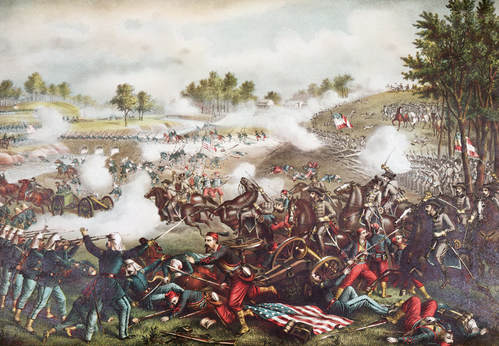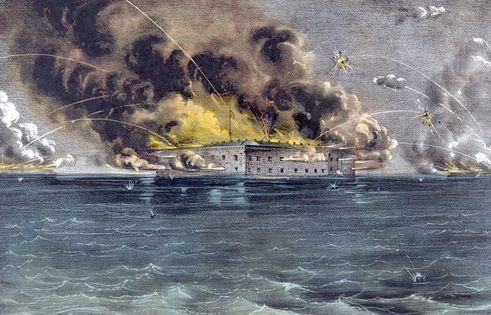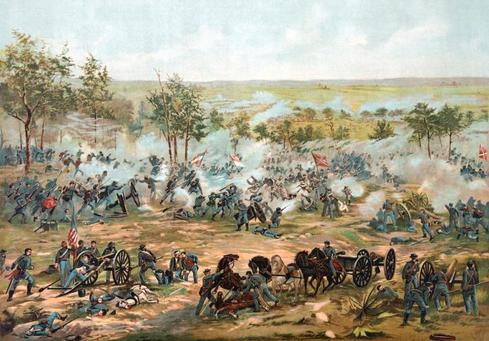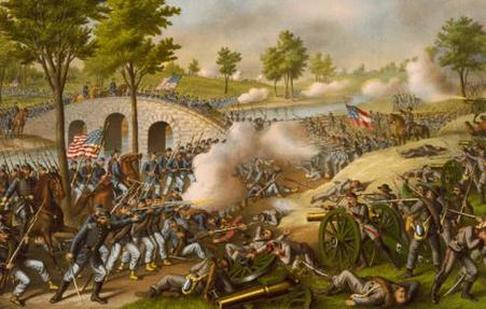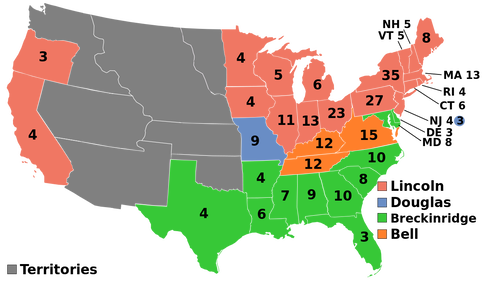|
Learning Target:
I can discuss the key military and political turning points of the Civil War. Critical Vocabulary: Nat Turner’s Rebellion, Underground Railroad, Harriett Tubman, “Fire-Eaters,” Stephen A. Douglas, Compromise of 1850, Fugitive Slave Act, Harriet Beecher Stowe, Uncle Tom’s Cabin, Ostend Manifesto, Kansas-Nebraska Act, New England Emigrant Aid Company, “Bleeding Kansas,” Republican Party, Dred Scott Decision, Abraham Lincoln, Freeport Doctrine, John Brown, Pottawatomie Creek, Lecompton Constitution, Harpers Ferry, Constitutional Union Party, Election of 1860, Crittenden Compromise, Confederate States of America, Jefferson Davis, First Inaugural Address, Fort Sumter Today's Agenda:
Homework: The Civil War Reading Learning Target:
I can discuss the key military and political turning points of the Civil War. Critical Vocabulary: Nat Turner’s Rebellion, Underground Railroad, Harriett Tubman, “Fire-Eaters,” Stephen A. Douglas, Compromise of 1850, Fugitive Slave Act, Harriet Beecher Stowe, Uncle Tom’s Cabin, Ostend Manifesto, Kansas-Nebraska Act, New England Emigrant Aid Company, “Bleeding Kansas,” Republican Party, Dred Scott Decision, Abraham Lincoln, Freeport Doctrine, John Brown, Pottawatomie Creek, Lecompton Constitution, Harpers Ferry, Constitutional Union Party, Election of 1860, Crittenden Compromise, Confederate States of America, Jefferson Davis, First Inaugural Address, Fort Sumter Today's Agenda:
Homework: The Civil War Reading Learning Target:
I can discuss the key military and political turning points of the Civil War. Critical Vocabulary: Nat Turner’s Rebellion, Underground Railroad, Harriett Tubman, “Fire-Eaters,” Stephen A. Douglas, Compromise of 1850, Fugitive Slave Act, Harriet Beecher Stowe, Uncle Tom’s Cabin, Ostend Manifesto, Kansas-Nebraska Act, New England Emigrant Aid Company, “Bleeding Kansas,” Republican Party, Dred Scott Decision, Abraham Lincoln, Freeport Doctrine, John Brown, Pottawatomie Creek, Lecompton Constitution, Harpers Ferry, Constitutional Union Party, Election of 1860, Crittenden Compromise, Confederate States of America, Jefferson Davis, First Inaugural Address, Fort Sumter Today's Agenda:
Homework: The Civil War Reading Learning Target:
I can summarize the events that led to the Civil War, & I can evaluate the degree to which each contributed to the conflict. Critical Vocabulary: Nat Turner’s Rebellion, Underground Railroad, Harriett Tubman, “Fire-Eaters,” Stephen A. Douglas, Compromise of 1850, Fugitive Slave Act, Harriet Beecher Stowe, Uncle Tom’s Cabin, Ostend Manifesto, Kansas-Nebraska Act, New England Emigrant Aid Company, “Bleeding Kansas,” Republican Party, Dred Scott Decision, Abraham Lincoln, Freeport Doctrine, John Brown, Pottawatomie Creek, Lecompton Constitution, Harpers Ferry, Constitutional Union Party, Election of 1860, Crittenden Compromise, Confederate States of America, Jefferson Davis, First Inaugural Address, Fort Sumter Today's Agenda:
Homework: The Civil War Reading Learning Target:
I can summarize the events that led to the Civil War, & I can evaluate the degree to which each contributed to the conflict. Critical Vocabulary: Nat Turner’s Rebellion, Underground Railroad, Harriett Tubman, “Fire-Eaters,” Stephen A. Douglas, Compromise of 1850, Fugitive Slave Act, Harriet Beecher Stowe, Uncle Tom’s Cabin, Ostend Manifesto, Kansas-Nebraska Act, New England Emigrant Aid Company, “Bleeding Kansas,” Republican Party, Dred Scott Decision, Abraham Lincoln, Freeport Doctrine, John Brown, Pottawatomie Creek, Lecompton Constitution, Harpers Ferry, Constitutional Union Party, Election of 1860, Crittenden Compromise, Confederate States of America, Jefferson Davis, First Inaugural Address, Fort Sumter Today's Agenda:
Homework: On the Brink of War Reading earning Target:
I can summarize the events that led to the Civil War, & I can evaluate the degree to which each contributed to the conflict. Critical Vocabulary: Nat Turner’s Rebellion, Underground Railroad, Harriett Tubman, “Fire-Eaters,” Stephen A. Douglas, Compromise of 1850, Fugitive Slave Act, Harriet Beecher Stowe, Uncle Tom’s Cabin, Ostend Manifesto, Kansas-Nebraska Act, New England Emigrant Aid Company, “Bleeding Kansas,” Republican Party, Dred Scott Decision, Abraham Lincoln, Freeport Doctrine, John Brown, Pottawatomie Creek, Lecompton Constitution, Harpers Ferry, Constitutional Union Party, Election of 1860, Crittenden Compromise, Confederate States of America, Jefferson Davis, First Inaugural Address, Fort Sumter Today's Agenda:
Homework: On the Brink of War Reading Learning Target:
I can summarize the events that led to the Civil War, & I can evaluate the degree to which each contributed to the conflict. Critical Vocabulary: Nat Turner’s Rebellion, Underground Railroad, Harriett Tubman, “Fire-Eaters,” Stephen A. Douglas, Compromise of 1850, Fugitive Slave Act, Harriet Beecher Stowe, Uncle Tom’s Cabin, Ostend Manifesto, Kansas-Nebraska Act, New England Emigrant Aid Company, “Bleeding Kansas,” Republican Party, Dred Scott Decision, Abraham Lincoln, Freeport Doctrine, John Brown, Pottawatomie Creek, Lecompton Constitution, Harpers Ferry, Constitutional Union Party, Election of 1860, Crittenden Compromise, Confederate States of America, Jefferson Davis, First Inaugural Address, Fort Sumter Today's Agenda:
Homework: On the Brink of War Reading |
A life is not important except in the impact it has on other lives.
-Jackie Robinson AnnouncementsApril 20: Prom
April 28: AP Saturday May 3: No School May 9: On Demand Test May 10: AP Exam May 13: Science Test May 21: No School May 27: No School May 30: Last Day Due DatesArchives
May 2019
Visitors |
